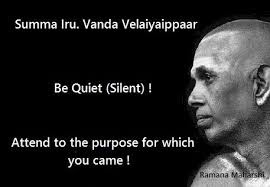Holding on to our Self - as Pure Existence - "I am" ~ Sadhana/ Manana from Katha Upanisad
Katha Upanisad verses that teach us how to recognize Atman as Pure Existence and be established in it, are discussed herewith.
naiva vAcA na manasA prAptum sAkyo na caksusA
asteeti bruvato'nyatra katham tad upalabhyate - 2.3.12
It cannot be attained through speech, nor through mind, nor through eye. How can It be known to anyone apart from him who speaks of It as existing.
EXT: Here the directness, aparokshanubhuti of AtmAnubhavam is stressed. It's the Real Me. It is known to everyone, when they clearly declare "I am".
However we focus on "I am Eashwar" or "I am father of my son" etc.... instead on the self-evident truth - "I am" which is Pure Existence - Sat - Svarupa lakshanam of Brahman.
Reflecting on the divine, infinite nature of our Pure Existence is the key lesson here.
Simply Be !
(தாயுமானவர் Tāyumānavar (1705–1744), was a Tamil Bhakti/JnAni - whose poetic outpourings are cherished in Saiva Siddhanta and Advaita Vedantins in general)
-------------------------------------------------------
Next verse, and Sri Sankara's Bhasyam is beautifully laying this out for our inner reflection (Manana) and consistent abidance (Nididhyasana)
asteeti evopalabdhavyas tattva bhAvena cobhayoh
asteeti evolapadhasya tattva-bhAvah prasidati - 2.3.13
The Self is (first) to be realised as existing, and (then) as It really is. Of these two (aspects), the real nature of the Self that has been known as merely existing, becomes favorably disposed (for self-revelation).
EXT: This verse clearly emphasizes that first we have to know of Atman's existence as "I am" - Sat and consciousness, within the confines of the perishable body, mind, intellect.....
Then upon examination of its nature, as revealed in scriptures (Pramana) and verifiable by our simple experience - across three states - i.e. to such a SraddhAvan - the infinite nature of Self, as Pure Existence - is revealed.
It's ever revealed as "I am" - Pure Existence without ArOpana (superimposition) of name, form, qualities etc...
Now let's reflect on Sri Sankara's commentary, with Bhakti: -
QUOTE
asti iti eva upalabdhasya - of that very Self which was earlier realised as existing (as immanent in the midst of perishable i.e. body etc) .......... that real aspect of that very Self - prasidati, becomes favorably disposed for revealing Itself—i.e. to the man who had realised It earlier as existing immanently (i.e. within the body, mind complex.... as " I am")
The real aspect being that from which all limiting adjuncts have vanished, which is different from the known and the unknown, is non-dual by nature, and is ascertained by such Vedic texts as, “not this, not this” (Br. Upanisad), “not gross, not subtle, not short” (Br. Up), “in the changeless, bodiless, inexpressible...........” (Tai.Up)
UNQUOTE
---------
EXT: Holding on, undistracted to one's svaswarupam as Atman - Pure Existence - asti - iti-eva upalabdhasya - we can recognize our infinite non-dual nature - unconditioned by time, space, name, form, body, likes, dislikes etc... as the infinite Brahman.
To do that, first we must learn to develop Sraddha in Sruti and pay attention to the Self as the pulsating consciousness-existence, as the very core of our Being. This Self - expressed itself in everyone as "I am".
When one does this consistently, i.e pays attention to Self which reveals itself as pure Being - i.e. "I am" ..... this devotion to Self - makes the Self - reveals itself.
Holding on to "I am" - as pure existence is the Key Sadhana. This however is done with Sraddha in Sruti, Guru and personal experience of holding on to "I am" - pure being, consciousness as my Self.
-------------------------------------------------------
The Last verse of the Katha Upanisad - makes the purpose of life and means to it directly !
angustha mAtrah puruso'ntarAtmA sadA janAnAm hrdaye sannivistah
tamsvAc chareerAt pravrhen munjAd iveseekAm dhairyena
tam vidyAc chukram amrtam
tam vidyAc chukram amrtam iti - 2.3.17
Purusa, the indwelling Self, of the size of a thumb, is ever seated in the hearts of men. One should unerringly separate Him from one’s body like a stalk from the Munja grass.
Him one should know as pure and immortal.
Him one should know as pure and immortal.
EXT: This ability to separate the Atman (which is ever revealed as "I am" experience across waking, dream and deepsleep) from anatman - is the first step and with Sruti Pramana - leard to recognize the infinite nature of Self.
Now let's reflect on Sri Sankara Bhasyam, with Bhakti
dhairyena, unerringly; isikam iva munjat like a stalk from the Munja grass, that is inside it.
vidyat, one should know; tarn, that thing—the absolute Consciousness as drawn out from the body—to be sukram amrtam as pure and immortal—to be the Brahman previously described.
The repetition (of “Him one should know as pure and immortal”), as also the word iti (i.e. in amrtam iti) is to show that the Upanisad (i.e. Brahma Vidya Upadesam) is concluded.





Comments
Post a Comment